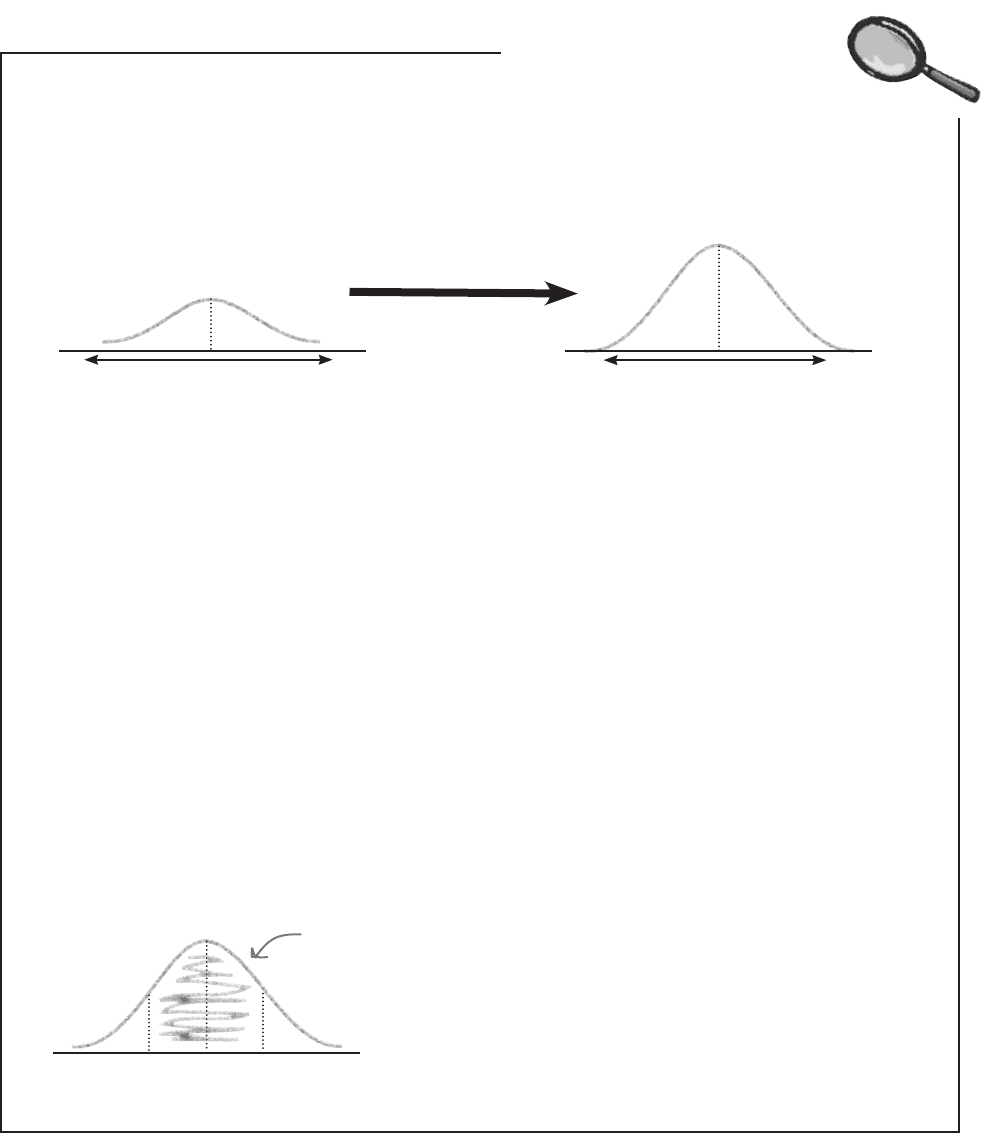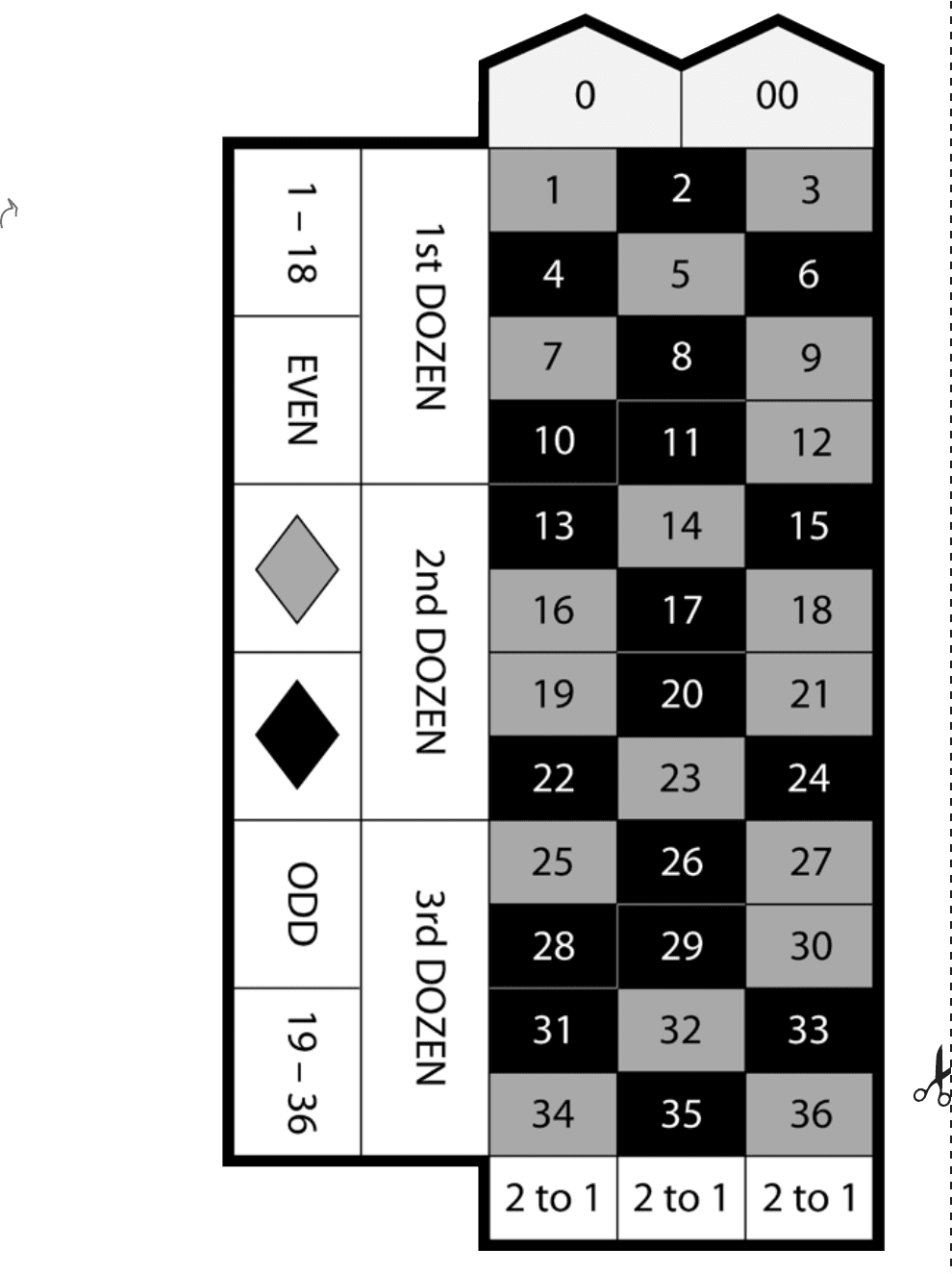Griffiths D. Head First Statistics
Подождите немного. Документ загружается.


you are here 4 121
measuring variability and spread
Standard Scores Up Close
Standard scores work by transforming sets of data into a new, theoretical distribution
with a mean of 0 and a standard deviation of 1. It’s a generic distribution that can
be used for comparisons. Standard scores effectively transform your data so that it
fits this model while making sure it keeps the same basic shape.
Standard scores can take any value, and they indicate position relative to the mean.
Positive z-scores mean that your value is above the mean, and negative z-scores
mean that your value is below it. If your z-score is 0, then your value is the mean
itself. The size of the number shows how far away the value is from the mean.
Standard deviations from the mean
Sometimes statisticians express the relative position of a particular value in terms
of standard deviations from the mean. As an example, a statistician may
say that a particular value is within 1 standard deviation of the mean. It’s really
just another way of indicating how close values are to the mean, but what does it
mean in practice?
We’ve seen that using z-scores transforms your data set into a generic distribution
with a mean of 0 and a standard deviation of 1. If a value is within 1 standard
deviation of the mean, this tells us that the standard score of the value is between
-1 and 1. Similarly, if a value is within 2 standard deviations of the mean, the
standard score of the value would be somewhere between -2 and 2.
Standard
score = number
of standard
deviations from
the mean.
μ
σ
μ = 0
σ = 1
-1 0 1
If a value is within 1 standard
deviation of the mean, it’s
within this area here—the
central part of the data.
μ

122 Chapter 3
The variance and standard deviation measure
how values are dispersed by looking at how far
values are from the mean.
The variance is calculated using
An alternate form is
The standard deviation is equal to the square root
of the variance, and the variance is the standard
deviation squared.
Standard scores, or z-scores, are a way of
comparing values across different sets of data
where the means and standard deviations are
different. To find the standard score of a value x,
use:
x
2
-
2
n
Q:
So variance and standard deviation both measure the
spread of your data. How are they different from the range?
A: The range is quite a simplistic measure of the spread of your
data. It tells you the difference between the highest and lowest
values, but that’s it. You have no way of knowing how the data is
clustered within it.
The variance and standard deviation are a much better way
of measuring the variability of your data and how your data is
dispersed, as they take into account how the data is clustered.
They look at how far values typically are from the center of
your data.
Q:
And what’s the difference between variance and
standard deviation? Which one should I use?
A: The standard deviation is the square root of the variance,
which means you can find one from the other.
The standard deviation is probably the most intuitive, as it tells you
roughly how far your values are, on average, from the mean.
Q:
How do standard scores fit into all this?
A: Standard scores use the mean and standard deviation to
convert values in a data set to a more generic distribution, while at
the same time, making sure your data keeps the same basic shape.
They’re a way of comparing different values across different data
sets even when the data sets have different means and standard
deviations. They’re a way of measuring relative standing.
Q:
Do standard scores have anything to do with detecting
outliers?
A:
Good question! Determining outliers can be subjective, but
sometimes outliers are defined as being more than 3 standard
deviations of the mean. Statisticians have different opinions about
this though, so be warned.
no dumb questions
(x
- )
2
n
x
-
z =

you are here 4 123
measuring variability and spread
Complete the table below. Name each type of measure of dispersion we’ve encountered
in the chapter, and show how to calculate it. Try your hardest to fill this out without
looking back through the chapter.
Statistic How to calculate
Range
Upper quartile - Lower quartile
Standard Deviation (σ)
Standard Score

124 Chapter 3
Complete the table below. Name each type of measure of dispersion we’ve encountered
in the chapter, and show how to calculate it. Try your hardest to fill this out without
looking back through the chapter.
Statistic How to calculate
Range
Upper bound - Lower bound
Interquartile range
Upper quartile - Lower quartile
Standard Deviation (σ)
(x - μ)
2
Standard Score
z = x - μ
Both of these give
the same result.
exercise solution
x
2
- μ
2
n
n
σ

you are here 4 125
measuring variability and spread
Let’s hear it for the
standard deviation,
our new team mascot!
Statsville All Stars win the league!
All the basketball matches for the season have now been played,
and the Statsville All Stars finished at the top of the league. You
clearly helped the coach pick the best player for the team.
Just remember: you owe it all to the friendly neighborhood
standard deviation.

this is a new chapter 127
calculating probabilities
4
Taking Chances
Life is full of uncertainty.
Sometimes it can be impossible to say what will happen from one minute to the
next. But certain events are more likely to occur than others, and that’s where
probability theory comes into play. Probability lets you predict the future by
assessing how likely outcomes are, and knowing what could happen helps you
make informed decisions. In this chapter, you’ll find out more about probability
and learn how to take control of the future!
What’s the probability he’s
remembered I’m allergic to
non-precious metals?

128 Chapter 4
Are you ready to play?
Fat Dan’s Grand Slam
Fat Dan’s Casino is the most popular casino in the
district. All sorts of games are offered, from roulette
to slot machines, poker to blackjack.
It just so happens that today is your lucky day. Head
First Labs has given you a whole rack of chips to
squander at Fat Dan’s, and you get to keep any
winnings. Want to give it a try? Go on—you know
you want to.
These are all your poker
chips; looks like you’re in
for a fun time.
There’s a lot of activity over at the roulette wheel,
and another game is just about to start. Let’s see
how lucky you are.
One of Fat Dan’s croupiers
welcome to fat dan’s casino

you are here 4 129
calculating probabilities
Roll up for roulette!
You’ve probably seen people playing roulette in movies even
if you’ve never tried playing yourself. The croupier spins a
roulette wheel, then spins a ball in the opposite direction, and
you place bets on where you think the ball will land.
The roulette wheel used in Fat Dan’s Casino has 38 pockets
that the ball can fall into. The main pockets are numbered
from 1 to 36, and each pocket is colored either red or black.
There are two extra pockets numbered 0 and 00. These
pockets are both green.
You can place all sorts of bets with roulette. For instance,
you can bet on a particular number, whether that number
is odd or even, or the color of the pocket. You’ll hear more
about other bets when you start playing. One other thing to
remember: if the ball lands on a green pocket, you lose.
Roulette boards make it easier to keep track of which
numbers and colors go together.
Lightest gray = green
black = black,
medium gray = red,
Roulette wheel
Roulette board. (See
page 130 for a larger
version.)
You place bets on the
pocket the ball will
fall into on the wheel
using the board.
If the ball falls
into the 0 or 00
pocket, you lose!

130 Chapter 4
Your very own roulette board
You’ll be placing a lot of roulette bets in this chapter.
Here’s a handy roulette board for you to cut out and
keep. You can use it to help work out the probabilities in
this chapter.
roulette board
Just be careful with those scissors.
